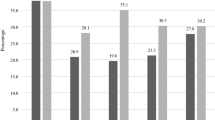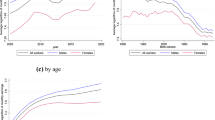Abstract
This paper investigates the non-marital fertility evolution in the USA for the period between 1976 and 2016. Beyond the well-known determinants in this framework, we add and test for the Easterlin relative income hypothesis. Easterlin stresses the role of the material aspirations formed in childhood (denominator) relative to the current economic perspectives (numerator) of young men. That ratio defines the relative income. We employ panel dynamic techniques at the state level. We find a negative and statistically significant effect of the relative income in the share of children born out-of-wedlock. Most importantly, relative income is robust to the inclusion of marriage. The latter may imply a socio-economic mobility perspective.



Similar content being viewed by others
Notes
For an informative review of the Easterlin hypothesis, see Macunovich (1998).
Willoughby and James (2017) provide some evidence that young men in the USA wish to create their own family despite the fact they delay it. A fact they have called the “marriage paradox”.
\(\bar{T}=\frac{n}{N}\), where n refers to the total number of usable observations and N denotes the number of individuals (states). For more details see Bruno (2005a).
For technical reasons that relate to the STATA command (xtlsdvc) of the Bruno (2005b) bias-corrected estimator, we were forced to exclude the state-specific time trends in this case. As a mere substitute for the latter, we used a general time trend.
The Hansen test is not provided by STATA for the heterogeneous slopes.
References
Akerlof GA, Yellen JL, Katz ML (1996) An analysis of out-of-wedlock childbearing in the United States. Q J Econ 111(2):277–317
Bellido H, Molina JA, Solaz A, Stancanelli E (2016) Do children of the first marriage deter divorce? Econ Model 55:15–31
Bertrand M, Kamenica E, Pan J (2015) Gender identity and relative income within households. Q J Econ 130(2):571–614
Blomquist J, Westerlund J (2013) Testing slope homogeneity in large panels with serial correlation. Econ Lett 121(3):374–378
Born B, Breitung J (2016) Testing for serial correlation in fixed-effects panel data models. Econom Rev 35(7):1290–1316
Bruno GS (2005) Approximating the bias of the LSDV estimator for dynamic unbalanced panel data models. Econ Lett 87(3):361–366
Bruno GS (2005) Estimation and inference in dynamic unbalanced panel-data models with a small number of individuals. Stata J 5(4):473–500
Bun MJ, Kiviet JF (2003) On the diminishing returns of higher-order terms in asymptotic expansions of bias. Econ Lett 79(2):145–152
De Hoyos RE, Sarafidis V (2006) Testing for cross-sectional dependence in panel-data models. Stata J 6(4):482–496
Driscoll JC, Kraay AC (1998) Consistent covariance matrix estimation with spatially dependent panel data. Rev Econ Stat 80(4):549–560
East PL (1998) Racial and ethnic differences in girls’ sexual, marital, and birth expectations. J Marriage Fam 60(1):150
Easterlin RA (1966) On the relation of economic factors to recent and projected fertility changes. Demography 31(1):31–153
Ellwood DT, Jencks C (2004) The spread of single-parent families in the United States since 1960. Harvard University John F. Kennedy School of Government Faculty Research Working Papers Series.
Espenshade TJ (1985) Marriage trends in America: estimates, implications, and underlying causes. Popul Dev Rev 193–245
Flood S, King M, Ruggles S, Warren JR (2015) Integrated public use microdata series, current population survey: version 4.0. [Machine-readable database]. Minneapolis: University of Minnesota, p 1
Garfinkel I, Huang CC, McLanahan SS, Gaylin DS (2003) The roles of child support enforcement and welfare in non-marital childbearing. J Popul Econ 16(1):55–70
Heuveline P, Timberlake JM, Furstenberg FF Jr (2003) Shifting childrearing to single mothers: results from 17 western countries. Popul Dev Rev 29(1):47–71
Hill MJ (2015) Easterlin revisited: relative income and the baby boom. Explor Econ Hist 56:71–85
Kearney MS, Levine PB (2011) Income inequality and early non-marital childbearing: an economic exploration of the “culture of despair”. National Bureau of Economic Research
Kearney MS, Levine PB (2012) Why is the teen birth rate in the United States so high and why does it matter? J Econ Perspect 26(2):141–63
Kearney MS, Wilson R (2018) Male earnings, marriageable men, and nonmarital fertility: evidence from the fracking boom. Rev Econ Stat 100(4):678–690
Kennedy S, Bumpass L (2008) Cohabitation and children’s living arrangements: new estimates from the United States. Demogr Res 19:1663
Kripfganz S, Sarafidis V (2021). Xtivdfreg: Stata module to perform defactored instrumental variables estimation of large panel data models
Liang LA, Berger U, Brand C (2019) Psychosocial factors associated with symptoms of depression, anxiety and stress among single mothers with young children: A population-based study. J Affect Disord 242:255–264
Lichter DT, McLaughlin DK, Ribar DC (1997) Welfare and the rise in female-headed families. Am J Sociol 103(1):112–143
Loibl C (2017) Living in poverty: understanding the financial behaviour of vulnerable groups. Econ Psychol 421–434
Macunovich D (2011) Re-visiting the Easterlin hypothesis: marriage in the US 1968–2010. IZA Discussion Papers (5886)
Macunovich DJ (1998) Fertility and the Easterlin hypothesis: An assessment of the literature. J Popul Econ 11(1):53–111
Manning WD, Cohen JA (2015) Teenage cohabitation, marriage, and childbearing. Popul Res Policy Rev 34(2):161–177
Mincer J (1984) Human capital and economic growth. Econ Educ Rev 3(3):195–205
Moffitt R (1992) Incentive effects of the US welfare system: A review. J Econ Lit 30(1):1–61
Moffitt R (1994) Welfare effects on female headship with area effects. J Hum Res 29(2):621–636
Moffitt RA (2001) Policy interventions, low-level equilibria, and social interactions. Soc Dyn 4(45–82):6–17
Moore KA, Redd Z, Burkhauser M, Mbwana K, Collins A (2002) Children in poverty: trends, consequences and policy options. Child Trends, Washington
Murnane RJ (2007) Improving the education of children living in poverty. Future Child 161–182
Murray C (2008) Losing ground: American social policy, 1950–1980. Basic Books, New York
Ní Bhrolcháin M, Beaujouan É (2012) Fertility postponement is largely due to rising educational enrolment. Popul Stud 66(3):311–327
Nickell S (1981) Biases in dynamic models with fixed effects. Econom J Econom Soc 1417–1426
Norkutė M, Sarafidis V, Yamagata T, Cui G (2021) Instrumental variable estimation of dynamic linear panel data models with defactored regressors and a multifactor error structure. J Econom 220(2):416–446
Oliva-Moreno J (2012) Loss of labour productivity caused by disease and health problems: what is the magnitude of its effect on Spain’s economy? Eur J Health Econ 13(5):605–614
Olsen RJ, Farkas G (1990) The effect of economic opportunity and family background on adolescent cohabitation and childbearing among low-income blacks. J Law Econ 8(3):341–362
Pesaran MH (2007) A simple panel unit root test in the presence of cross-section dependence. J Appl Economet 22(2):265–312
Pesaran MH (2015) Testing weak cross-sectional dependence in large panels. Economet Rev 34(6–10):1089–1117
Pesaran MH (2021) General diagnostic tests for cross-sectional dependence in panels. Empir Econ 60:13–50
Pierce M, Hope HF, Kolade A, Gellatly J, Osam CS, Perchard R (2020) Effects of parental mental illness on children’s physical health: systematic review and meta-analysis. Br J Psychiatry 217(1):354–363
Pop-Eleches C (2010) The supply of birth control methods, education, and fertility evidence from Romania. J Hum Resour 45(4):971–997
Qian Z, Lichter DT, Mellott LM (2005) Out-of-wedlock childbearing, marital prospects and mate selection. Soc Forces 84(1):473–491
Ray D (2006) Aspirations, poverty, and economic change. Underst Poverty 1:409–421
Rosenfeld MJ, Roesler K (2019) Cohabitation experience and cohabitation’s association with marital dissolution. J Marriage Fam 81(1):42–58
Sarafidis V, Wansbeek T (2012) Cross-sectional dependence in panel data analysis. Economet Rev 31(5):483–531
Schneider D (2015) The great recession, fertility, and uncertainty: evidence from the United States. J Marriage Fam 77(5):1144–1156
Schneider D, Gemmill A (2016) The surprising decline in the non-marital fertility rate in the United States. Popul Dev Rev 627–649
Schneider D, Hastings OP (2015) Socioeconomic variation in the effect of economic conditions on marriage and nonmarital fertility in the United States: Evidence from the great recession. Demography 52(6):1893–1915
South SJ, Crowder K (2010) Neighborhood poverty and nonmarital fertility: spatial and temporal dimensions. J Marriage Fam 72(1):89–104
Sweeney MM (2002) Two decades of family change: the shifting economic foundations of marriage. Am Sociol Rev 132–147
Van de Kaa DJ (1987) Europe’s second demographic transition. Popul Bull 42(1):1–59
Willis RJ (1999) A theory of out-of-wedlock childbearing. J Polit Econ 107(S6):S33–S64
Willoughby BJ, James SL (2017) The marriage paradox: why emerging adults love marriage yet push it aside. Oxford University Press, Oxford
Wursten J (2018) Testing for serial correlation in fixed-effects panel models. Stata J 18(1):76–100
Acknowledgements
This paper has been significantly improved by the comments received from the editor, Joakim Westerlund, and two anonymous referees. The authors are grateful to them.
Author information
Authors and Affiliations
Corresponding author
Ethics declarations
Conflict of interest
None of the authors has any conflict of interest to disclose.
Additional information
Publisher's Note
Springer Nature remains neutral with regard to jurisdictional claims in published maps and institutional affiliations.
Appendix
Appendix
See Tables 3, 4, 5, 6, 7 and 8.
Rights and permissions
Springer Nature or its licensor holds exclusive rights to this article under a publishing agreement with the author(s) or other rightsholder(s); author self-archiving of the accepted manuscript version of this article is solely governed by the terms of such publishing agreement and applicable law.
About this article
Cite this article
Mavropoulos, G., Panagiotidis, T. The role of relative income in the share of children born out-of-wedlock in the USA. Empir Econ 64, 1105–1120 (2023). https://doi.org/10.1007/s00181-022-02285-7
Received:
Accepted:
Published:
Issue Date:
DOI: https://doi.org/10.1007/s00181-022-02285-7




